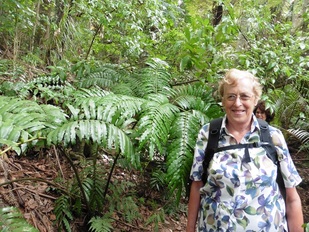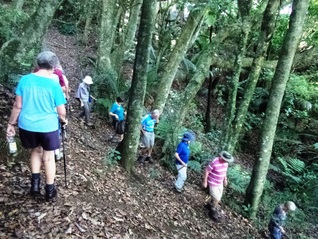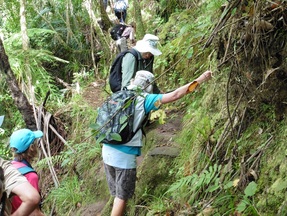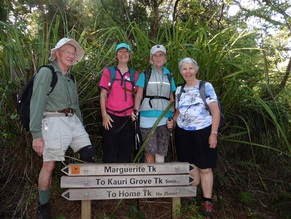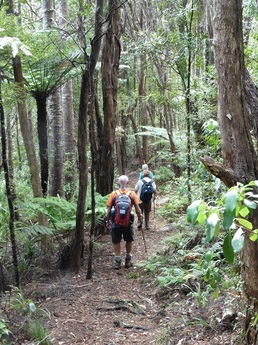Trip Reports, March 2015
Pukekohe and Papakura Reserves
22 March 2015
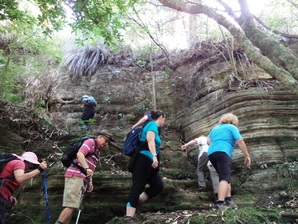 Clambering up to the top of Puke-Kiwi-o-Riki pa site
Clambering up to the top of Puke-Kiwi-o-Riki pa site
On a lovely day 37 of us enjoyed exploring four different bush areas in South Auckland. Our first stop was Rooseville Park Scenic Reserve in Pukekohe. This is covered in mature and regenerating bush and is considered the most significant stand of forest in Pukekohe today. It is home to the endangered king fern - we saw several healthy specimens, and Hall's Totara which has a distinctive bark. The name Rooseville came from the Roose family who emigrated from Cornwall in 1859 and settled in the area.
Our second stop was Margan's Bush in the Red Hill area of Papakura. Out of former wasteland, enthusiastic locals with the help of the Lions Club, have replanted native plants and built tracks and bridges. Trees that feature are Rewarewa, Taraire, Tawa and a Kahikatea canopy. We saw a kereru and could hear tui and other birds.
Puke-Kiwi-o-Riki pa site was our third stop and was just up the road from Margan's Bush. This pa site is above a rocky outcrop which provided walkers with a sort steep climb. Once up we were rewarded with extensive views of the Manukau and South Auckland. On such a clear day it was possible to see as far as the Manukau Heads. We enjoyed our lunch there.
After lunch we travelled over to the other side of the motorway and did a harbourside walk along the south side of the Pahurehure Inlet. At this time the tide was in and it looked at its best. Earlier in the day when travelling to Pukekohe the tide was out and it was all mudflats. Much of this area is a modern housing estate still under development. However it was interesting to see wetlands which had been developed and the planting of native plants along the shoreline. We saw a large wetlands area which had native plants and waterlilies with resident swans, ducks, white faced herons, shags and kingfishers.
Thank you to Joan, Praemi and Sharleen
Our second stop was Margan's Bush in the Red Hill area of Papakura. Out of former wasteland, enthusiastic locals with the help of the Lions Club, have replanted native plants and built tracks and bridges. Trees that feature are Rewarewa, Taraire, Tawa and a Kahikatea canopy. We saw a kereru and could hear tui and other birds.
Puke-Kiwi-o-Riki pa site was our third stop and was just up the road from Margan's Bush. This pa site is above a rocky outcrop which provided walkers with a sort steep climb. Once up we were rewarded with extensive views of the Manukau and South Auckland. On such a clear day it was possible to see as far as the Manukau Heads. We enjoyed our lunch there.
After lunch we travelled over to the other side of the motorway and did a harbourside walk along the south side of the Pahurehure Inlet. At this time the tide was in and it looked at its best. Earlier in the day when travelling to Pukekohe the tide was out and it was all mudflats. Much of this area is a modern housing estate still under development. However it was interesting to see wetlands which had been developed and the planting of native plants along the shoreline. We saw a large wetlands area which had native plants and waterlilies with resident swans, ducks, white faced herons, shags and kingfishers.
Thank you to Joan, Praemi and Sharleen
Marguerite Track, Waitakere Ranges
8 March 2015
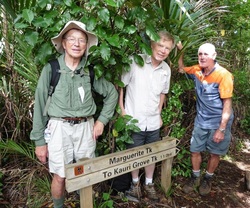 The Leaders of the day, John, Donald and Derek
The Leaders of the day, John, Donald and Derek
Often in the weekends, botanist Marguerite Crookes would take her university students on field trips in the Waitakere Ranges. These trips were so popular that 90 years ago she founded The Auckland Natural History Club so that other Aucklanders could enjoy the beauty of our magnificent native bush . So thirty-five of us did the club’s customary five yearly walk along the Marguerite Track to commemorate those excursions.
Spraying our boots with trigene first, to prevent spread of Kauri dieback disease, we went down the Kauri Grove Track and on to the Marguerite Track. On this track the vegetation is particularly lush, with lots of ferns and mosses. When we reached the Home Track we received the welcome news that this was the morning tea break.
Then it was all downhill, the bush was now more open and it was drier underfoot. On the Winstone Track the soil was rather impoverished in places, with kauri and tanekaha predominating, together with other hardy vegetation underneath. There were patches of taraire too, its leathery leaves lying on the ground and slow to decompose.
Following the Kauri Grove Track (now on the Hillary Trail) we reached the top of the Kitekite Falls. This is the site of the ill-fated kauri dam. Here we noted the three grooves cut into the rock on each side of the stream where once the beams supporting the floor of the dam had lain.
After a quick lunch break we crossed over the stream and proceeded to the bottom of the Kitiekite Falls. What a sight, a fantastic worms-eye view looking across at one of the most popular sights for tourists in the Waitakere area. Across the stream again onto the Kitekite Track, just stopping for the photo shoot of the three main drops of the falls, and so down to the first bridge where we crossed over the stream onto the Byers Walk, then on through the nikau grove where we admired the enormous ancient rata tree. Shortly after we saw evidence of kauri milling in the past - the large rock with grooves carved into it to take the wires of the boom which held back the kauri logs, and across the stream the steel spikes which anchored the other end of the boom. We viewed too a mock-up of the wooden railway lines over which the Piha Tramway had transported the milled timber round the coast to the waiting ships at Whatipu in the early 1900s.
And so it was back to the waiting bus, first inspecting the enormous kauri stump displayed at the end of Glen Esk Road. A longer than usual day but one full of interest. And of course a walk to be repeated in another five years, keeping our founder's particular love of the Waitakere Ranges alive in the club.
Thank you, Donald, John and Derek for this memorable day!
Spraying our boots with trigene first, to prevent spread of Kauri dieback disease, we went down the Kauri Grove Track and on to the Marguerite Track. On this track the vegetation is particularly lush, with lots of ferns and mosses. When we reached the Home Track we received the welcome news that this was the morning tea break.
Then it was all downhill, the bush was now more open and it was drier underfoot. On the Winstone Track the soil was rather impoverished in places, with kauri and tanekaha predominating, together with other hardy vegetation underneath. There were patches of taraire too, its leathery leaves lying on the ground and slow to decompose.
Following the Kauri Grove Track (now on the Hillary Trail) we reached the top of the Kitekite Falls. This is the site of the ill-fated kauri dam. Here we noted the three grooves cut into the rock on each side of the stream where once the beams supporting the floor of the dam had lain.
After a quick lunch break we crossed over the stream and proceeded to the bottom of the Kitiekite Falls. What a sight, a fantastic worms-eye view looking across at one of the most popular sights for tourists in the Waitakere area. Across the stream again onto the Kitekite Track, just stopping for the photo shoot of the three main drops of the falls, and so down to the first bridge where we crossed over the stream onto the Byers Walk, then on through the nikau grove where we admired the enormous ancient rata tree. Shortly after we saw evidence of kauri milling in the past - the large rock with grooves carved into it to take the wires of the boom which held back the kauri logs, and across the stream the steel spikes which anchored the other end of the boom. We viewed too a mock-up of the wooden railway lines over which the Piha Tramway had transported the milled timber round the coast to the waiting ships at Whatipu in the early 1900s.
And so it was back to the waiting bus, first inspecting the enormous kauri stump displayed at the end of Glen Esk Road. A longer than usual day but one full of interest. And of course a walk to be repeated in another five years, keeping our founder's particular love of the Waitakere Ranges alive in the club.
Thank you, Donald, John and Derek for this memorable day!
